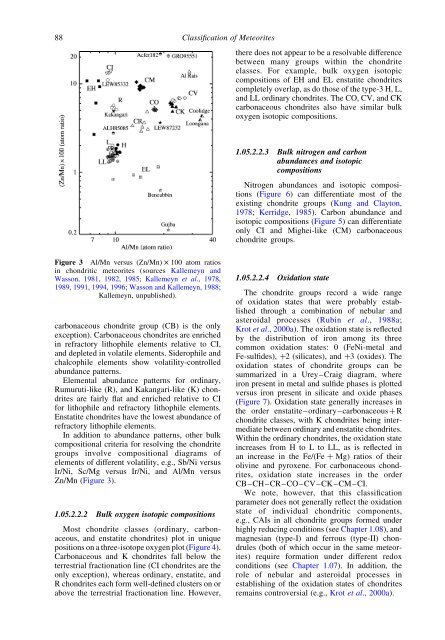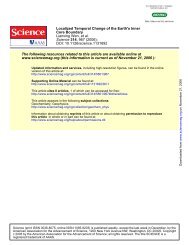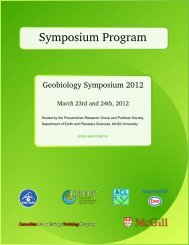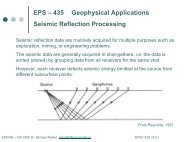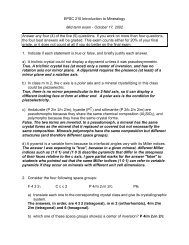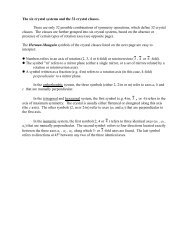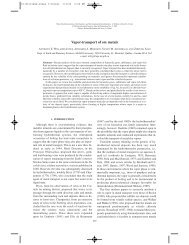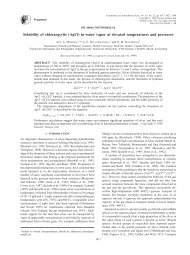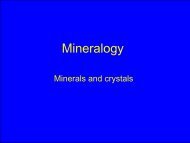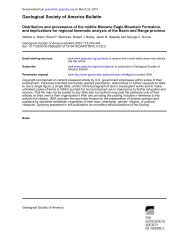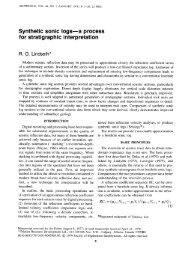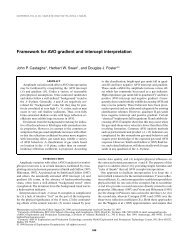05 Classification of.. - Department of Earth and Planetary Sciences
05 Classification of.. - Department of Earth and Planetary Sciences
05 Classification of.. - Department of Earth and Planetary Sciences
You also want an ePaper? Increase the reach of your titles
YUMPU automatically turns print PDFs into web optimized ePapers that Google loves.
88<br />
<strong>Classification</strong> <strong>of</strong> Meteorites<br />
there does not appear to be a resolvable difference<br />
between many groups within the chondrite<br />
classes. For example, bulk oxygen isotopic<br />
compositions <strong>of</strong> EH <strong>and</strong> EL enstatite chondrites<br />
completely overlap, as do those <strong>of</strong> the type-3 H, L,<br />
<strong>and</strong> LL ordinary chondrites. The CO, CV, <strong>and</strong> CK<br />
carbonaceous chondrites also have similar bulk<br />
oxygen isotopic compositions.<br />
1.<strong>05</strong>.2.2.3 Bulk nitrogen <strong>and</strong> carbon<br />
abundances <strong>and</strong> isotopic<br />
compositions<br />
Nitrogen abundances <strong>and</strong> isotopic compositions<br />
(Figure 6) can differentiate most <strong>of</strong> the<br />
existing chondrite groups (Kung <strong>and</strong> Clayton,<br />
1978; Kerridge, 1985). Carbon abundance <strong>and</strong><br />
isotopic compositions (Figure 5) can differentiate<br />
only CI <strong>and</strong> Mighei-like (CM) carbonaceous<br />
chondrite groups.<br />
Figure 3 Al/Mn versus (Zn/Mn) £ 100 atom ratios<br />
in chondritic meteorites (sources Kallemeyn <strong>and</strong><br />
Wasson, 1981, 1982, 1985; Kallemeyn et al., 1978,<br />
1989, 1991, 1994, 1996; Wasson <strong>and</strong> Kallemeyn, 1988;<br />
Kallemeyn, unpublished).<br />
carbonaceous chondrite group (CB) is the only<br />
exception). Carbonaceous chondrites are enriched<br />
in refractory lithophile elements relative to CI,<br />
<strong>and</strong> depleted in volatile elements. Siderophile <strong>and</strong><br />
chalcophile elements show volatility-controlled<br />
abundance patterns.<br />
Elemental abundance patterns for ordinary,<br />
Rumuruti-like (R), <strong>and</strong> Kakangari-like (K) chondrites<br />
are fairly flat <strong>and</strong> enriched relative to CI<br />
for lithophile <strong>and</strong> refractory lithophile elements.<br />
Enstatite chondrites have the lowest abundance <strong>of</strong><br />
refractory lithophile elements.<br />
In addition to abundance patterns, other bulk<br />
compositional criteria for resolving the chondrite<br />
groups involve compositional diagrams <strong>of</strong><br />
elements <strong>of</strong> different volatility, e.g., Sb/Ni versus<br />
Ir/Ni, Sc/Mg versus Ir/Ni, <strong>and</strong> Al/Mn versus<br />
Zn/Mn (Figure 3).<br />
1.<strong>05</strong>.2.2.2 Bulk oxygen isotopic compositions<br />
Most chondrite classes (ordinary, carbonaceous,<br />
<strong>and</strong> enstatite chondrites) plot in unique<br />
positions on a three-isotope oxygen plot (Figure 4).<br />
Carbonaceous <strong>and</strong> K chondrites fall below the<br />
terrestrial fractionation line (CI chondrites are the<br />
only exception), whereas ordinary, enstatite, <strong>and</strong><br />
R chondrites each form well-defined clusters on or<br />
above the terrestrial fractionation line. However,<br />
1.<strong>05</strong>.2.2.4 Oxidation state<br />
The chondrite groups record a wide range<br />
<strong>of</strong> oxidation states that were probably established<br />
through a combination <strong>of</strong> nebular <strong>and</strong><br />
asteroidal processes (Rubin et al., 1988a;<br />
Krot et al., 2000a). The oxidation state is reflected<br />
by the distribution <strong>of</strong> iron among its three<br />
common oxidation states: 0 (FeNi-metal <strong>and</strong><br />
Fe-sulfides), þ2 (silicates), <strong>and</strong> þ3 (oxides). The<br />
oxidation states <strong>of</strong> chondrite groups can be<br />
summarized in a Urey–Craig diagram, where<br />
iron present in metal <strong>and</strong> sulfide phases is plotted<br />
versus iron present in silicate <strong>and</strong> oxide phases<br />
(Figure 7). Oxidation state generally increases in<br />
the order enstatite–ordinary–carbonaceousþR<br />
chondrite classes, with K chondrites being intermediate<br />
between ordinary <strong>and</strong> enstatite chondrites.<br />
Within the ordinary chondrites, the oxidation state<br />
increases from H to L to LL, as is reflected in<br />
an increase in the Fe/(Fe þ Mg) ratios <strong>of</strong> their<br />
olivine <strong>and</strong> pyroxene. For carbonaceous chondrites,<br />
oxidation state increases in the order<br />
CB–CH–CR–CO–CV–CK–CM–CI.<br />
We note, however, that this classification<br />
parameter does not generally reflect the oxidation<br />
state <strong>of</strong> individual chondritic components,<br />
e.g., CAIs in all chondrite groups formed under<br />
highly reducing conditions (see Chapter 1.08), <strong>and</strong><br />
magnesian (type-I) <strong>and</strong> ferrous (type-II) chondrules<br />
(both <strong>of</strong> which occur in the same meteorites)<br />
require formation under different redox<br />
conditions (see Chapter 1.07). In addition, the<br />
role <strong>of</strong> nebular <strong>and</strong> asteroidal processes in<br />
establishing <strong>of</strong> the oxidation states <strong>of</strong> chondrites<br />
remains controversial (e.g., Krot et al., 2000a).


